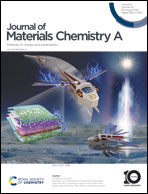An ethyl bromofluoroacetate redox mediator enables a robust LiF-rich solid electrolyte interphase for advanced lithium–oxygen batteries†
Abstract
The high charging overpotential and poor stability of the lithium anode severely restrict the development of non-aqueous Li–O2 batteries. Herein, to overcome both intractable challenges, ethyl bromofluoroacetate (EBFA) is introduced into Li–O2 batteries as an innovative bifunctional redox mediator (RM). Through a particular electrochemical pretreatment method in an argon-filled atmosphere, EBFA reacts on the surface of the lithium anode, leading to the dissociation of Br− and F− from EBFA molecules. The generated Br− acts as the effective component of the RM, considerably reducing the charging overpotential of the Li–O2 battery. At the same time, a robust LiF-rich solid electrolyte interphase (SEI) is in situ formed on the surface of the lithium anode. The formed SEI film, with high lithium-ion conductivity and outstanding stability, significantly protects the lithium anode from the growth of lithium dendrites. Hence, the addition of EBFA in a TEGDME-based non-aqueous electrolyte solution enables a stable Li–O2 coin battery operation up to 265 cycles.



 Please wait while we load your content...
Please wait while we load your content...